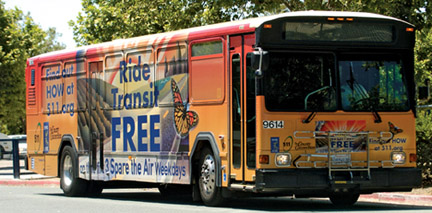No fare! Thanks for sparing the air." Thatís the upbeat message that greeted transit riders throughout the nine-county San Francisco Bay Area during a three-day smog alert in late June.

Eye-catching buses wrapped in Spare the Air colors, including this County Connection bus in Contra Costa County, carried the free transit message around the Bay Area.
By Brenda Kahn
Published: August, 2006
No fare! Thanks for sparing the air. Thatís the upbeat message that greeted transit riders throughout the nine-county San Francisco Bay Area during a three-day smog alert in late June.
The free-ride promotion proved to be so popular that the Metropolitan Transportation Commission and the Bay Area Air Quality Management District moved quickly to extend the promotion beyond the initial three-day scope and to essentially double their free-ride offer to six days.
Under the original plan announced this past spring, MTC and the Air District committed to providing free transit rides on the first three Spare the Air non-holiday weekdays during the 2006 summer/fall smog season, setting aside $7.5 million to reimburse the 25 participating transit agencies for lost fares.
In a departure from past Spare the Air campaigns, MTC and the Air District decided to make the free-ride offer good throughout the day and into the evening instead of just during the morning commute.
The new approach was put to the test early in the season when record high temperatures and low winds combined to trigger alerts on three back-to-back weekdays in June. The extended hours proved to be just the ticket; compared to typical weekday patterns, nearly a half million additional travelers flocked to the regionís busses, trains and ferries, bumping up ridership by about 10 percent across the board over the course of the three-day alert.
While the free-ride promotion had the intended effect of significantly boosting ridership during the midday as well as commute hours, certain hot spots, nonetheless, experienced exceedances of the federal eight-hour standard for ozone (the main ingredient in smog) during the three-day June alert.
The region did the best it could, considering the weather, said MTC spokesman Randy Rentschler. These ridership gains are still very impressive.
Buoyed by the enthusiastic ridership showing, and determined to ward off further air quality exceedances, MTC and the Air District scrambled to come up with another $6 million to fund free transit rides on an additional three Spare the Air days. The two agencies acted just in time for a second series of air alert days that occurred in July.
The innovative smog-busting campaign has caught the eye of the California Council for Environmental and Economic Balance, which recently recognized MTC, BART and the Bay Area Air Quality Management District with the prestigious Edmund G. ĎPatí Brown Award for their partnership in initiating the Spare the Air free-transit program, which is now in its third year.
The public can receive advance notification of Spare the Air days by registering for AirAlerts at the website: www.sparetheair.org
Spare the Air Stats
Behind the healthy 10 percent overall surge in transit ridership across the Bay Area during the summerís first three Spare the Air days (compared to typical weekday patterns) are some phenomenal numbers, particularly among ferry systems.
The Alameda-Oakland Ferry (to San Francisco) reported a 190 percent increase in riders over the course of the three days, while Golden Gate Transit reported a 269 percent rise in passengers on the Sausalito-San Francisco ferry and a 74 percent increase on the Larkspur-S.F. ferry.
Caltrain enjoyed a 44 percent leap in ridership along its 77-mile route linking San Francisco to San Jose and Gilroy.
In terms of sheer numbers of new passengers, San Francisco Muni is in first place, with more than 135,000 additional riders taking advantage of the free-ride offer (representing a 7 percent increase).
The East Bayís AC Transit also had a good showing, with a 15 percent rise in ridership that translated to 94,000 extra riders on its buses. BARTís 8 percent rise translated to 78,000 additional riders. Next in line was the Valley Transportation Authority in Santa Clara County, with nearly 56,000 new riders (a 14 percent jump on its buses and a 20 percent increase on its light-rail lines).

